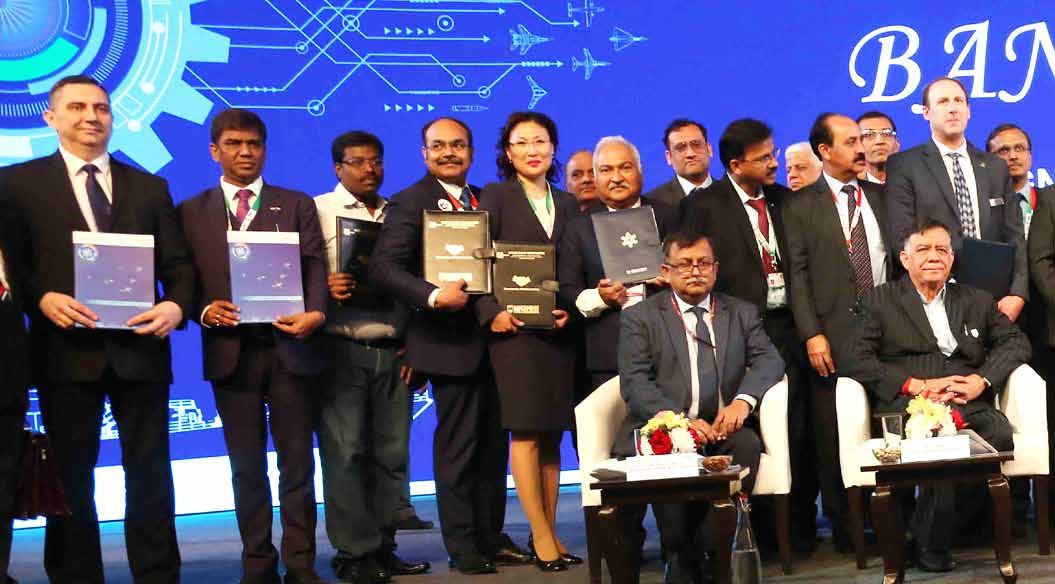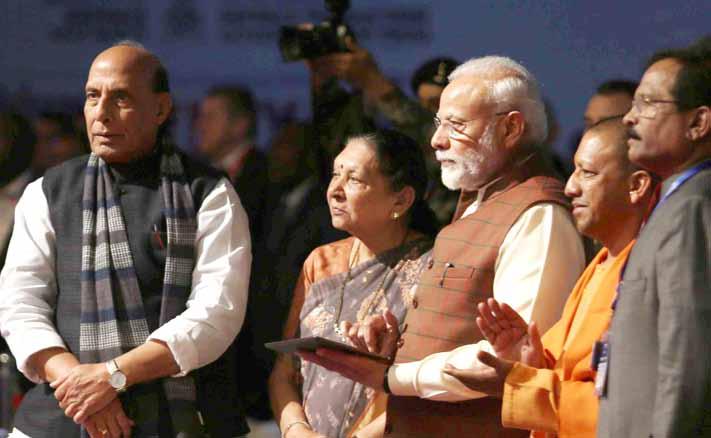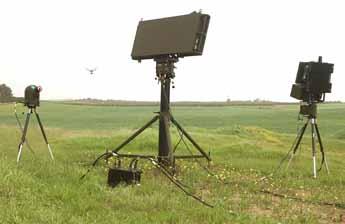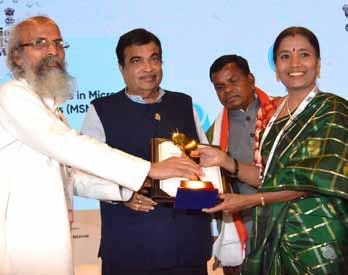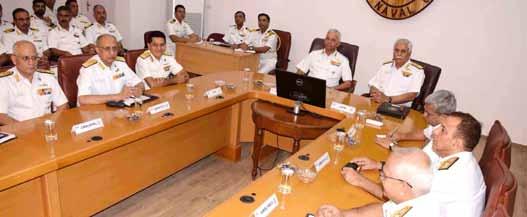
8 minute read
HAL Hands Over 50th Set of L-40 Stage of GSLV-MKII
HAL Hands Over 50th Set of L-40 Stage of GSLV-MKII to ISRO
Hindustan Aeronautics Limited has handed over the 50th L-40 stage of Geo Synchronous Launch Vehicle (GSLVMKII) to Indian space Research Organisation at a special function.
Advertisement
This L-40 stage is meant for GSLV MKIIF12 Flight planned by ISRO in August 2020. The Aerospace Division of HAL has so far integrated and supplied L-40 stages for 12 flights of GSLV MKII including the GSLV MKII -F10 flight in the first week

of March. Apart from the Integrated L-40 stages, HAL is manufacturing the riveted structures, propellant tanks, feedlines of PSLV, GSLV MKII and GSLV MKIII launch vehicles and structures of various satellites for ISRO. HAL is one of the most reliable partners of ISRO for the past three decades and has contributed and participated in almost all of ISRO’s ambitious projects namely Chandrayaan-I, Chandrayaan-II, Mangalyaan and upcoming projects like Gaganyaan.
Rear Admiral Krishna D Swaminathan taken over as Chief of Western Command
The Western Fleet, known as the ‘Sword Arm’ of the Indian Navy, witnessed a change of helm. The event was held at sea onboard the aircraft carrier INS Vikramaditya. The baton of the Flag Officer Commanding Western Fleet was handed

over by Rear Admiral Sanjay Jasjit Singh, AVSM, NM to the new Fleet Commander, Rear Admiral Krishna D Swaminathan, VSM. The new Fleet Commander is an alumnus of the National Defence Academy (NDA), a specialist in Communications and Electronic Warfare and has commanded frontline warships such as INS Vidyut, INS Vinash, INS Kulish, INS Mysore and aircraft carrier INS Vikramaditya. The Western Fleet has been at the forefront of all naval operations across the Arabian Sea and Indian Ocean Region since its inception, consistently executing the military, diplomatic, constabulary and benign roles of the Indian Navy. The Fleet has grown in capacity and capability over the years and presently include the aircraft carrier, multi-role destroyers and frigates, fleet tankers, three air squadrons and integral flights.
Lincad, UK designer and manufacturer of specialist batteries and charging systems, has won a significant new contract from Team Leidos to supply a range of cells and batteries for ultimate use by British armed forces.
In addition to its own bespoke products, Lincad supplies cells and batteries of various chemistries from other manufacturers, using its extensive in-house testing facilities to approve products and to demonstrate continued product performance over time. This is critical where products are used for mission-critical environments, with many requiring approval to UK Defence Standards. Lincad will also be employing its capacity to package and label supplied products for all modes of transport, including full adherence with the stringent IATA regulations. The company’s own Dangerous Goods Safety Adviser (DGSA) supports all aspects of product supply. Peter Slade, Lincad’s Joint Managing Director, commented, “We’re pleased to have won an additional contract from Team Leidos. We have been supplying products to military customers, including the UK MOD, for more than 30 years. This win highlights the confidence that defence customers have in Lincad to supply high performance product, often in very large volumes, at a competitive price.” Lincad wins additional contract from Team Leidos
Defence Minister inaugurates new LCH Production Hangar at HAL

Rear Admiral Sanjay Vatsayan takes over as Eastern Fleet Commander G overnment has adopted Prime Minister Narendra Modi’s mantra of “Make in India’, for India and the world” to build strong defence and security infrastructure in the country, said Defence
Minister Rajnath Sing. He was inaugurating the new Light Combat Helicopter Production Hangar at Helicopter Division in Hindustan Aeronautics Limited (HAL) Complex at Bengaluru.He said, in the last five years, India has made significant progress towards manufacturing military equipment indigenously under the ‘Make in India’ initiative.
Stressing that defence industry plays a major role in the economic development of the country, the minister lauded the significant contribution of organisations like HAL - a Defence Public Sector Undertaking (DPSU) that has helped India leapfrog six places to become the fifth largest economy in the world. He added that there has been increase in defence exports that have crossed Rs 17,000 crore in the last two years. Highlighting the Rs 35,000 crore exports target set for the coming years, the minister expressed confidence that HAL, through its various platforms, will contribute significantly in achieving this milestone.
Rajnath Singh commended HAL for being the backbone of the Indian Air Force and meeting the requirements of the Armed Forces. “The HAL has excelled both in operations and finance in the last five years. It has achieved operational clearance on seven platforms, including Light Combat Aircraft and Light Combat Helicopter, and overhauled platforms like Hawk and SU 30 MKI,” he said. He also appreciated that HAL had a turnover of Rs 19,705 crore till March 2019 and it gave shareholders a healthy dividend of 198 percent.
Noting that HAL is now facing stiff competition from private defence industries, the minister urged the DPSU to take this changing environment as a challenge and grab the opportunities to increase their competitiveness in the international market.
Speaking on the occasion, Chairman and Managing Director R. Madhavan said, LCH is completely ready for operational induction and the Helicopter Complex is fully geared up for its production. He added that the new production hangar will augment the LCH production capacity to reach a peak production of 30 helicopters per year.
HAL also apprised the minister on the progress of new design and development programme of indigenous Indian Multi Role Helicopter (IMRH). The full-scale mock-up was showcased to Shri Rajnath Singh. The IMRH is proposed as replacement to the existing medium lift helicopters such as Mi17’s, Kamovs and Seakings which will phase out in the next eight to ten years. LCH is a 5.5-tonne class combat helicopter designed and developed by HAL.
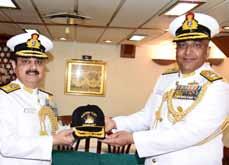
The command of the Eastern Fleet was handed over to Rear Admiral Sanjay Vatsayan, NM by Rear Admiral Suraj Berry, AVSM, NM, VSM at Visakhapatnam. The Eastern Fleet comprising of frontline warships of the Indian Navy are deployed across the indo-pacific region to safeguard the nation’s maritime interest. Rear Admiral Sanjay Vatsayan is a Gunnery & Missile systems specialist, has vast experience at sea and ashore. He has commanded missile vessels Vibhuti and Nashak, the guided-missile corvette Kuthar and has also been the commissioning Commanding Officer the indigenously constructed stateof-the-art stealth frigate Sahyadri.
IDSA renamed as Manohar Parrikar Institute for Defence Studies and Analyses I ndian Coast Guard Ship `Varad’, the fifth in the series of seven Offshore Patrol Vessels (OPVs) constructed by M/s Larsen & Toubro Ltd., was commissioned at Chennai by Mansukh Mandaviya, Minister of State for Shipping (Independent Charge) in the presence of Director General Krishnaswamy Natarajan, PTM, TM, Director General Indian Coast Guard and other senior dignitaries of the Central and State Government. This 98 meter OPV has been designed and built by M/s Larsen & Toubro Ltd at Kattupalli, Chennai and is fitted with stateof-the-art navigation and communication equipment, sensors and machinery. She will be equipped with 30mm and 12.7mm guns with FCS for enhancing the fighting efficiency. The other special features onboard are Integrated Bridge System (IBS), Integrated Platform Management System (IPMS), Automated Power Management System (APMS) and High Power External Fire-Fighting system. The ship is designed to carry one twin engine helicopter and four high speed boats including two rigid hull inflatable boats for swift boarding operations, Search and Rescue, Law Enforcement and Maritime Patrol. The ship is also capable of carrying Pollution Response equipment for oil spill response at sea.
The ship draws approx 2100 tons (GRT) and is propelled by two 9100kw diesel engines and attains a maximum speed of 26 knots, with an endurance of 5000 nautical miles. The sustenance and reach, coupled with the latest and modern equipment and systems, provides her the capability to perform the role of a Command platform to accomplish the Coast Guard Charter of Duties. The ship, on joining the Coast Guard North Eastern fleet, will be deployed extensively for EEZ surveillance and other duties as enshrined in the Coast Guard Charter, to safeguard the maritime interests of India. The Indian Coast Guard with this ship joining the fleet will have 147 ships & boats and 62 aircraft. Further, 58 ships are at various stages of construction at different Shipyards in India and 16 aircraft (ALH) are under production by M/s HAL, Bengaluru.
ICGS Varad is commanded by Commandant Pintu Bag and has a compliment of 11 officers and 91 men. Offshore Patrol Vessel (OPV) YARD 45005 ICGS VARAD commissioned

The Government has renamed ‘The Institute for Defence Studies
and Analyses’ (IDSA) as ‘Manohar Parrikar Institute for Defence Studies and Analyses’. The decision has been taken to honour the commitment and legacy of late Manohar Parrikar. It will align the vision and aspiration of the premier defence Institute with the contribution of the former defence minister and Padma Bhushan awardee. When Manohar Parrikar was defence minister, India witnessed a series of decisions that enhanced India’s security capacities, boosted indigenous defence production and bettered the lives of ex-servicemen. His biggest contribution was towards the implementation of long-standing One Rank One Pension (OROP) demand for the Armed Forces. He initiated major military reforms with the objective of having better teeth-to-tail ratio by setting up an expert committee under Lt Gen (Retd) DB Shekatkar for enhancing combat capability and rebalancing defence expenditure.
An autonomous body under Ministry of Defence, IDSA was established as a registered society in New Delhi in 1965, dedicated to objective research and policy relevant studies on all aspects of defence and security. The IDSA has a wellqualified multi-disciplinary research faculty drawn from academia, defence forces etc., representing a diversity of views. Research at the Institute is driven by a comprehensive agenda and the need to provide impartial analyses and policy recommendations.

